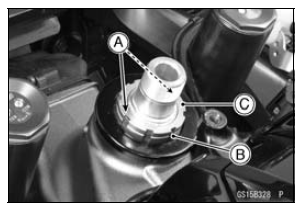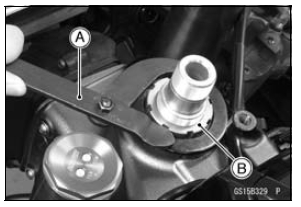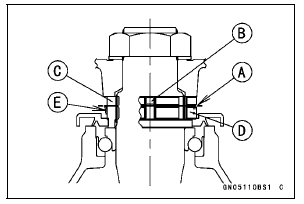


Special Tool - Steering Stem Nut Wrench: 57001-1100
If the steering is too tight, loosen the steering stem nut [B] a fraction of a turn.
If the steering is too loose, tighten the steering stem nut a fraction of a turn.

NOTE
Turn the steering stem nut 1/8 turn at time maximum.

NOTE
Tighten the stem head nut first, then the upper front fork clamp bolts.
Torque - Steering Stem Head Nut: 78 N·m (8.0 kgf·m, 58 ft·lb) Front Fork Clamp Bolts (Upper): 20 N·m (2.0 kgf·m, 15 ft·lb)
| WARNING If the handlebar does not turn to the steering stop it may cause an accident resulting in injury or death. Be sure the cables, harnesses and hoses are routed properly and do not interfere with handlebar movement (see Cable, Wire, and Hose Routing section in the Appendix chapter). |
If the steering is still too tight or too loose, repeat the adjustment.
 Steering Play Inspection
Steering Play Inspection Steering Stem Bearing Lubrication
Steering Stem Bearing LubricationLower Fairing Removal
Remove the quick rivets [A].
Remove:
Quick Rivets [A]
Bolts [B]
Pull up the core by the flat-head screwdriver (–), and then
remove the quick rivet.
Clear the hook portions on the upper edges [C] from the
slots, and remove the left lower fairing [D].
While pulling down ...
Exploded View
13. Front Wheel Rotation Sensor
B: Apply brake fluid.
L: Apply a non-permanent locking agent.
R: Replacement Parts
S: Follow the specified tightening sequence.
Si: Apply silicone grease (ex. PBC grease).
10. Rear Wheel Rotation Sensor
B: Apply brake fluid.
G: Apply gr ...
System Components
1. KIBS ECU
With input from the front and rear wheel sensors and front
caliper hydraulic pressure, the KIBS ECU analyzes various
conditions on the motorcycle, and with additional information
from the FI ECU (engine speed, throttle position, gear
position, and clutch actuation) precisely control ...